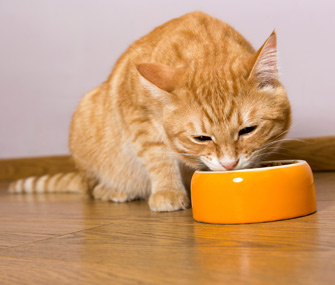Why Pets’ Nutrition Needs Change With Age
Published on April 08, 2015
Skip To

What Is Life-Stage and Lifestyle Nutrition?
Feeding foods designed to meet your pet’s optimal nutritional needs at a specific age or physiological state — such as diets designed for maintenance (basic upkeep to support health), reproduction, growth or senior pets — is known as life-stage nutrition. Lifestyle nutrition, on the other hand, takes into consideration the physiological needs of pets with certain lifestyles, such as working/active or sedentary.Life-stage and lifestyle nutrition both recognize the existence of an optimal nutrient range for pets. Your goal is to feed foods designed to meet your pet’s individual life-stage and lifestyle needs, while keeping him at a healthy weight. This approach is consistent with the goals of nutrition in general: feeding for peak health, performance and longevity. This is the key to life-stage nutrition and preventive medicine.
Conversely, products manufactured for all life stages contain nutrient and calorie levels designed to meet a pet’s greatest biological need (usually growth or reproduction). In other words, when your adult or senior pet eats an all-purpose food, he’s most likely consuming more nutrients and calories than a less-active pet needs. Feeding your pet food that’s above (or below) his optimal nutrient range may result in obesity or weight loss, subpar performance and overall poor health.
Though some pet owners consider a “plush” Persian cute and cuddly, obesity has serious health consequences for our pets.
So just what should your pet eat? To get the answer, speak with your pet’s veterinary health care team. They can assess your pet’s weight, health and activity level and recommend a diet and feeding amount that’s right for your pet. Ideally, this takes place before your pet has health problems. Often, nutritional needs associated with your pet’s breed, age and physiologic state are considered along with the goal of reducing various risk factors for disease — resulting in specific dietary recommendations.
The Pet-Obesity Epidemic
Obesity is a great example of this. Just like in people, pet obesity has reached epidemic proportions: An estimated 54 percent of dogs and cats in the United States are overweight or obese. In general, dogs and cats weighing 10 percent to 19 percent more than their ideal weight are considered overweight. Those weighing 20 percent or more than their optimum weight are considered obese. Though some consider this cute, the fact is that obesity isn’t just an aesthetic condition. It can have serious health consequences for our pets, potentially contributing to arthritis, diabetes mellitus, high blood pressure, cancer, skin conditions, kidney disease, heart and respiratory disease, as well as lower life expectancy. Obesity affects pets’ quality of life and leads to a reduced life expectancy. In cats, experts estimate that 31 percent of diabetes mellitus cases and 34 percent of lameness cases could be eliminated if cats were at optimum body weight. Experts show that dogs’ life spans increase by nearly two years when they maintain an optimal body condition.How Life-Stage and Lifestyle Nutrition Can Help
Is your pet overweight or at risk for being too heavy? To find out, ask your veterinarian to examine your pet and discuss potential risk factors including breed, age, decreased physical activity, type of food, feeding method and whether your pet is spayed or neutered. Surprised at that last one? Though spaying and neutering is critical to combat pet overpopulation, the altered hormone levels can change a pet’s activity level and caloric needs. Therefore, you need to adjust your spayed or neutered pet’s food intake. If you don’t decrease calories or increase activity, body weight and body fat will increase, resulting in an overweight or obese pet.Another risk factor you might be surprised by is feeding method. The risky approach: feeding your pets “free choice." This means you keep pets’ food bowls full, allowing them to choose when and how much they eat. As loving pet owners, many of us feed our cats and dogs unlimited amounts of highly palatable, energy-dense foods, either because we don’t know how much to feed or are too busy to measure. And, let’s face it, our pets are part of the family, and we love to “treat” them with food. In actuality, a brisk walk would be more enjoyable and better for both pets and people.
The positive angle of the pet-obesity problem is that obesity is one of the leading preventable causes of illness and death. The two main culprits of obesity — too much food and too little exercise — can be reversed. And your veterinary team can help. Talk to them about weight management and obesity prevention. They’ll help you determine how to use life-stage and lifestyle nutrition to decrease your pet’s calories, decrease his risk of obesity and increase his healthy outlook. Armed with this knowledge — and knowing the factors that lead to animal obesity — you’ll be able to feed your cat or dog the right foods the right way and get them exercising. The potential positive results — a better and longer life — are certainly food for thought.
More on Vetstreet:
- 6 Foods to Never Feed Your Cat
- Decoding Pet Food Labels
- Pet Food Labels: What Organic, Natural and Low-Fat Claims Really Mean
- 5 Things I Wish Every Pet Owner Knew
- The Best and Worst Fruits and Veggies for Pets





